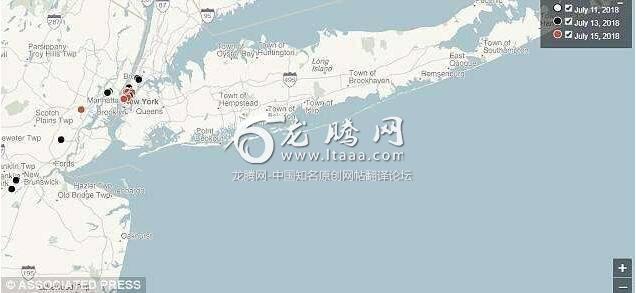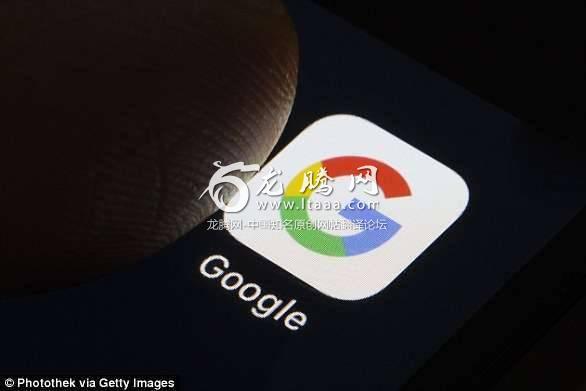【每日邮报】谷歌无视权限用你的手机追踪定位数据 [英国媒体]
谷歌实际上正在记录你所有的位置变化,即使你告诉它不要这样做!搜索公司无视权限用你的手机追踪定位数据。谷歌声称你能“暂停”历史位置来阻止追踪你的设备。
Google really IS recording your everymovement even when you tell it not to! Search firm tracks location data usingyour smartphone regardless of permissions
谷歌实际上正在记录你所有的位置变化,即使你告诉它不要这样做!搜索公司无视权限用你的手机追踪定位数据。
Google claims you can 'pause' Location History to stop tracking of your device
谷歌声称你能“暂停”历史位置来阻止追踪你的设备。
Experts found that even with this setting on, Google still monitor location data
专家发现即使有这个设置,谷歌仍然监视定位数据。
To provethis, Princeton postdoctoral researcher Gunes Acar carried an Androidsmartphone with the 'Location History' setting switched off.
为了证实,普林斯顿大学博士后研究员Gunes Acar带上一个关闭了“历史位置”的安卓智能手机。
Despitethe setting purportedly preventing data collection, researchers discoveredGoogle had kept records of Dr Acar's train commute on two trips to New York andvisits to the High Line park, Chelsea Market, Hell's Kitchen, Central Park andHarlem.
尽管这项设置据称能防止数据收集,研究员发现谷歌保存了关于Acar博士两次去纽约的火车通勤以及光临高架公园、切尔西市场、地狱厨房和哈莱姆区的记录。
Themovements tracked by Google have been plotted on a map by researchers. Toprotect the privacy of Dr Acar, researchers did not plot the most telling andfrequent marker – his home address.
研究员在一张地图上标记了被谷歌追踪的位置变化。为了保护Acar博士的隐私,研究员没有标记最说明问题以及频繁的标记——他的家庭地址。
Theresearchers found Google logs a record of your current location each time youopen its turn-by-turn navigation app, Google Maps. The daily weather updates onAndroid phones also provided another way to track movement.
Scrolldown for video.
研究员发现每当你启动谷歌的实时导航应用谷歌地图时,谷歌记录了一条关于你的当前位置的记录。安卓手机上的日常天气更新提供了另一种追踪位置变化的方式。
Researchers created a visual map of the movements of Princeton postdoctoral researcher Gunes Acar, who carried an Android phone with Location history off, and shared a record of his Google account (pictured)
研究员创建了一张关于普林斯顿大学博士后Acar的位置变化地图。他携带一个关闭历史位置的安卓手机,而且分享一条关于他的谷歌账户的纪录(被画出)
The finding was the result of an AssociatedPress (AP) investigation and was confirmed by computer-science researchers atPrinceton University.
这是一项美联社(AP)调查的结果并由普林斯顿大学计算机科学研究员证实。
For the most part, Google is upfront aboutasking permission to use your location information, the researchers found.
研究员发现,在大多数情况下,谷歌坦率地请求使用你的定位信息的权限。
An app like Google Maps will remind you toallow access to location if you use it for navigating.
If you agree to let it record your locationover time, Google Maps will display that history for you in a 'timeline' that mapsout your daily movements.
一款像谷歌地图这样的应用会提醒你允许访问定位信息,如果你使用它来导航。如果你同意让它持续记录你的位置,谷歌地图将在一个标绘了你的日常位置变化的“时间线”中显示你的历史。
Storing your minute-by-minute travelscarries privacy risks and has been used by police to determine the location ofsuspects – such as a warrant that police in Raleigh, North Carolina, served onGoogle last year to find devices near a murder scene.
储存你的实时旅程带有隐私风险,曾经被警察用来决定疑犯的位置——有项来自北卡罗莱纳州罗利警方的令状,由谷歌提供服务以便发现一次谋杀现场附近的设备。
(下划线部分是引用美联社的内容)
HOW DOES GOOGLE TRACK ITSUSERS' LOCATIONS OUTSIDE OF 'LOCATION HISTORY'?
谷歌如何在“定位历史之外”追踪用户的位置?
A newinvestigation led by the Associated Press found that some Google appsautomatically store time-stamped location data without asking - even whenyou've paused Location History.
由AP领导的一项新调查发现一些谷歌应用未经询问自动储存标记时间的位置数据,即使你已经暂停了定位历史。
Theinvestigation found, for example:
比如,调查发现:
Google stores a snapshot of where you are when you open its Maps app
当你启动谷歌地图时谷歌储存一条关于你的当前位置的简介。
Automatic daily weather updates on Android phones pinpoint where you are each time the forecast is refreshed
安卓手机上的自动日常天气更新在每次更新预报时定位你的位置。
Simple searchers, such as 'chocolate chip cookies,' or 'kids science kits,' pinpoint your precise latitude and longitude – accurate to the square foot - and save it to your Google account
简单搜索,比如“碎巧克力饼干”或者“儿童科学工具套件”,定位你的精确经纬度——精确到平方英尺,并在你的谷歌账户中保存它。
This informationis all logged as part of the 'Web and App Activity feature, which does notspecifically reference location information in itsdescription.
这些信息都被记录,作为“网页和应用活动特性”的一部分。在其描述中没有专门提到需要引用定位信息。
This is enabledby default, and stores a variety of information from Google apps and websitesto your Google account.
这个是默认开启的,而且储存来自谷歌应用和网页的各种各样的信息到你的谷歌账户中。
When paused, itwill prevent activity on any device from being saved to youraccount.
当被暂停时,将防止任何设备上的活动被储存到你的账户。
Leaving 'Web& App Activity' on and turning 'Location History' off only prevents Googlefrom adding your movements to the 'timeline,' its visualization of your dailytravels.
开启“网页和应用活动”并关闭“定位历史”仅仅防止谷歌将你的位置变化加进“时间线”,它是你的日常出行的视觉化。
It does not stopGoogle's collection of other location markers.
其不会停止谷歌的关于其他定位标记的收集。
To prevent this, the company will let you'pause' a setting called Location History.
为了防止收集定位信息,谷歌会让你“暂停”一个叫做“定位历史”的设置。
Google says the settings will prevent thecompany from remembering the locations you have visited.
谷歌表示,这些设置将阻止该公司储存你访问过的地点。
Google's support page on the subjectstates: 'You can turn off Location History at any time.'
With Location History off, the places yougo are no longer stored, the firm claims.
相关谷歌支持页面宣称:“你随时可以关闭定位历史。”谷歌声称关闭定位历史后你去过的地方不再被储存。
However, the latest findings suggest thisisn't true.
然而,最新的发现表明这不是真的。
Even with Location History paused, someGoogle apps automatically store time-stamped location data without asking.
即使已经暂停了定位历史,一些谷歌应用未经询问自动储存标记时间的位置数据,。
For example, Google stores a snapshot ofwhere you are when you merely open its Maps app.
比如,当你仅仅打开谷歌地图时谷歌储存一个你的当前位置的简介。
This photo, taken on July 25, 2018, shows Kalyanaraman Shankari, right, and her husband Thomas Raffill, left, who noticed that her Android phone prompted her to rate a shopping trip to Kohl's, even though she had turned Location History off
图片拍摄于2018年7月25日,右边是Kalyanaraman Shankari,左边是她的丈夫Thomas Raffill,她注意到她的安卓手机提醒她评价一趟科尔士百货公司的购物之行,即使她关闭了定位历史。
Automatic daily weather updates on Androidphones also pinpoint roughly where you are each time the forecast is refreshedby the device.
安卓手机上日常天气的自动更新也会在更新预报时定位你的位置。
And some searches that have nothing to dowith location, like 'chocolate chip cookies,' or 'kids science kits,' pinpointyour precise latitude and longitude – accurate to the square foot - and save itto your Google account.
而且一些研究发现即使无关位置的使用,比如搜索“碎巧克力饼干”和“儿童工具套件”也会定位你的精确经纬度——精确到平方英尺,并将其存入你的谷歌账户。
The privacy issue affects some two billionusers of devices that run Google's Android operating software and hundreds ofmillions of worldwide iPhone users who rely on Google for maps or search.
这个隐私问题涉及约20亿运行安卓系统的设备的用户和全球数亿使用谷歌导航和搜索的IPhone用户
Storing location data in violation of auser's preferences is wrong, said Jonathan Mayer, a Princeton computerscientist and former chief technologist for the Federal CommunicationsCommission's enforcement bureau.
违反用户的偏好收集位置数据是错误的,Jonathan Mayer说。他是一名普林斯顿大学的计算机科学家以及前联邦通信委员会执行局首席技术专家。
A researcher from Dr Mayer's lab confirmedthe AP's findings on multiple Android devices; the AP conducted its own testson several iPhones that found the same behaviour.
来自Mayer博士的实验室的一名研究员证实了AP的关于数个安卓设备的结果;AP主导的在一些IPhone上进行的测试也发现了一样的行为。
'If you're going to allow users to turn offsomething called 'Location History,' then all the places where you maintainlocation history should be turned off,' Dr Mayer said. 'That seems like apretty straightforward position to have.'
“如果你打算允许用户关闭叫做‘定位历史’的东西,那么应该真的做到。”Mayer博士说。“那个似乎是最简单不过的态度。”
HOW CAN YOU FIND AND DELETE WHERE GOOGLE KNOWSYOU'VE BEEN?
怎么找到并删除让谷歌知道你在哪里的东西
That should prevent precise locationmarkers from being stored to your Google account.
Google will warn you that some of itsservices won't work as well with these settings off.
那应该防止精确的定位标记被存入你的谷歌账户。谷歌会警告当关闭这些时它的一些服务将不会工作。
In particular, neither the GoogleAssistant, a digital concierge, nor the Google Home smart speaker will beparticularly useful.
准确地说,谷歌助手、数字前台、谷歌家居智能扬声器将受到影响。
On iOS
苹果操作系统
If you use Google Maps, adjust yourlocation setting to 'While Using' the app. This will prevent the app fromaccessing your location when it's not active.
如果你使用谷歌地图,将位置设置调整到“仅使用时”。这将防止应用未活动的时候访问你的位置。
Go to Settings Privacy Location Servicesand from there select Google Maps to make the adjustment.
在设置中的定位隐私服务中选中谷歌地图以做出调整。
In the Safari web browser, considerusing a search engine other than Google.
在Safari浏览器中,考虑使用谷歌之外的搜索引擎。
Under Settings Safari Search Engine, youcan find other options like Bing or DuckDuckGo.
在设置Safari搜索引擎中,可选项有Bing或者DuckDuckGo。
You can turn location off while browsingby going to Settings Privacy Location Services Safari Websites, and turn thisto 'Never.'
你可以在浏览中关闭定位,找到设置定位隐私服务Safari网站,将此项设为“从不”。
This still won't prevent advertisersfrom knowing your rough location based on IP address on any website.
这无法防止网页上的广告商通过IP地址知道你的大致位置。
You can also turn Location Services offto the device almost completely from Settings Privacy Location Services.
你也能在设置定位隐私服务中几近完全关闭对设备的定位服务。
Both Google Maps and Apple Mapswill still work, but they won't know where you are on the map and won't be ableto give you directions.
谷歌地图和苹果地图仍会工作,但它们不知道你在地图上的哪里因此不能导航。
Emergency responders will still be ableto find you if the need arises.
有需要时急救人员仍能找到你。
On Android
安卓操作系统
Under the main settings icon click on'Security & location.' Scroll down to the 'Privacy' heading. Tap'Location.' You can toggle it off for the entire device.
在设置中点击“安全&定位”。下滑到“隐私”标题。点击“定位”。你能关闭对设备的定位。
Use 'App-level permissions' to turn offaccess to various apps.
使用“应用级权限”关闭各种应用的访问。
Unlike the iPhone, there is no settingfor 'While Using.'
不像iPhone,没有“仅使用时”的设置。
You cannot turn off Google Playservices, which supplies your location to other apps if you leave that serviceon.
你不能关闭谷歌市场服务,它为其他应用提供定位服务。
Sign in as a 'guest' on your Androiddevice by swiping down from top and tapping the downward-facing cursor, thenagain on the torso icon.
在你的谷歌设备上以“来宾”身份登陆,从屏幕顶端下滑,点击方向朝下的光标,然后点击躯干图标。
Be aware of which services yousign in on, like Chrome. You can also change search engines even in Chrome.
知晓你登陆了哪些服务,像Chrome。在Chrome中也能更换搜索引擎。
To delete past location tracking on any device
在任何设备上删除位置追踪
On the page myactivity.google.com,look for any entry that has a location pin icon beside the word'details.'
在myactivity.google.com上,寻找任何在“细节”旁边有个大头针图标的条目。
Clicking on that pops up a window thatincludes a link that sometimes says 'From your current location.'
点击它会弹出一个包含一条连接的窗口,连接有时是“来自你的当前位置”。
Clicking on it will open Google Maps, whichwill display where you were at the time.
点击它会打开谷歌地图,显示当时你在什么地方。
You can delete it from this popup byclicking on the navigation icon with the three stacked dots and then 'Delete.'
你可以从这个弹出窗口删除它,通过点击带三个重叠的点的导航图标,然后“删除”。
Some items will be grouped in unexpectedplaces, such as topic names, google.com, Search, or Maps.
有些条目被分进意外的地方,比如主题名、谷歌主页、搜索或者地图。
You have to delete them item by item.You can wholesale delete all items in date ranges or by service, but will endup taking out more than just location markers.
你不得不逐项删除。你可以按时间或服务批量删除条目,但也会将无关定位的标记也删除。
Google says it is being perfectly clear.
谷歌说这是完全问心无愧的。
'There are a number of different ways thatGoogle may use location to improve people's experience, including: LocationHistory, Web and App Activity, and through device-level Location Services,' aGoogle spokesperson said in a statement to the AP.
“谷歌可能使用各种方式定位以改善用户体验,包括:定位历史、网页和应用活动,以及设备级定位服务。”谷歌的一名发言人在回应AP的一份声明中说。
'We provide clear descriptions of thesetools, and robust controls so people can turn them on or off, and delete theirhistories at any time.'
“我们提供这些工具的清楚描述,以及鲁棒的控制这样用户能开启或关闭它们,以及在任何时候删除他们的历史。”
To stop Google from saving these locationmarkers, the company says, users can turn off another setting, one that doesnot specifically reference location information.
为了阻止谷歌储存这些定位标记,谷歌说,用户可以关闭另一项设置,其没有专门引用定位信息
You can see the stored location markers ona page in your Google account at myactivity.google.com, although they'retypically scattered under several different headers, many of which areunrelated to location.
你能在myactivity.google.com上登陆你的账户看到保存的定位标记,虽然它们分散在一些不同标题下,许多与定位无关。
Huge tech companies are under increasingscrutiny over their data practices, following a series of privacy scandals atFacebook and new data-privacy rules recently adopted by the European Union.
技术巨头们面临的数据活动监管与日俱增,在一系列脸书隐私丑闻和欧盟最近通过的数据隐私条例后。
Last year, the business news site Quartzfound that Google was tracking Android users by collecting the addresses ofnearby cellphone towers even if all location services were off.
去年,商业新闻网站Quartz发现谷歌通过收集附近的信号塔地址追踪安卓用户,即使任何定位服务都被关闭。
Google changed the practice and insisted itnever recorded the data anyway.
谷歌转变了这项活动并坚称没有记录任何数据。
You can see the stored location markers on a page in your Google account at myactivity.google.com, although they're typically scattered under several different headers, many of which are unrelated to location (stock image)
你能在myactivity.google.com上登陆你的账户看到保存的定位标记,虽然它们分散在一些不同标题下,许多与定位无关。(图库图片)
On Android, the popup explains that 'placesyou go with your devices will stop being added to your Location History map.'On the iPhone, it simply reads, 'None of your Google apps will be able to storelocation data in Location History.'
在安卓上,弹出窗口解释“你和你的设备到过的地方将不会加进你的定位历史地图。”在IPhone上,则是简单宣读。“你的谷歌应用无一允许储存定位数据进你的定位历史。”
The iPhone text is technically true ifpotentially misleading. With Location History off, Google Maps and other appsstore your whereabouts in a section of your account called 'My Activity,' not'Location History.'
IPhone文本技术上是真的,如果有潜在的误导。定位历史关闭时,谷歌地图及其他应用在你的账户被称为“我的活动”的部分储存你的下落,而不是在“定位历史”。
Since 2014, Google has let advertiserstrack the effectiveness of online ads at driving foot traffic , a feature thatGoogle has said relies on user location histories.
从2014年起,谷歌允许广告商追踪在线广告吸引流量的效果,这是一项谷歌说依赖用户定位历史的特性。
The company is pushing further into suchlocation-aware tracking to drive ad revenue, which rose 20 per cent last yearto $95.4 billion (£75bn).
谷歌更进一步使用定位知晓的追踪以推动广告收入,其去年增长了20%到954亿美元(750亿英镑)。
At a Google Marketing Live summit in July,Google executives unveiled a new tool called 'local campaigns' that dynamicallyuses ads to boost in-person store visits. It says it can measure how well acampaign drove foot traffic with data pulled from Google users' locationhistories.
7月在一场实况转播的谷歌营销峰会上,谷歌执行官们揭示了一个新工具叫做“当地运作”,它动态地使用广告推动亲临的商店光顾。据说其能用来自谷歌用户的“定位历史”测量一次运作的带动流量的效果。
They continue todo so, even when there is no SIM card inserted or apps running, it isclaimed.
据称甚至当无SIM卡插入或应用运行时,他们仍在继续做。
The findingraises worrying privacy concerns over the gathering of such detailed locationdata.
结果引发了关于收集这些详细的定位数据的令人担忧的隐私关注。
As part of an in-depth investigation for Quartz, it was discovered that, since the beginning of 2017, Android phones have been collecting the addresses of nearby mobile transmitter towers
作为Quartz的深度调查的一部分,发现从2017年开始,安卓手机收集附近的移动信号塔的位置。
Knowing thelocation of one nearby cell tower is not enough to identify the specificlocation of a handset, and it's user.
通过蜂窝信号塔知道某人的位置不足以认定一个设备及其使用者的具体位置。
But by usingdata from multiple towers, a location can be triangulated within about aquarter-mile radius.
但是通过使用来自多个信号塔的数据,1/4英里内的一个位置可通过三角定位得出。
This becomeseven more precise in built up areas like cities.
这种方法甚至在建成区内比如城市更加精确。
Although thedata sent is encrypted, a third party could make use of it if the handset hasbeen infected with spyware, malware or other hacking tools.
虽然送出的数据被加密,但是如果设备感染后门、恶意程序或其他黑客工具,第三人可能使用它。
Every handsetalso has a unique ID number that can be associated with the locationdata.
Location-sharingdoes not appear to have been limited to a particular brand of Android phone ortablet.
每个设备也有一个独一无二的ID编号,与定位数据相联系。位置共享似乎并不局限于特定品牌的安卓手机或平板电脑
版权声明
我们致力于传递世界各地老百姓最真实、最直接、最详尽的对中国的看法
【版权与免责声明】如发现内容存在版权问题,烦请提供相关信息发邮件,
我们将及时沟通与处理。本站内容除非来源注明五毛网,否则均为网友转载,涉及言论、版权与本站无关。
本文仅代表作者观点,不代表本站立场。
本文来自网络,如有侵权及时联系本网站。
图文文章RECOMMEND
热门文章HOT NEWS
-
1
最近,新冠肺炎疫情在日本有扩大的趋势,有专家呼吁日本应当举国行动起来,共...
- 2
- 3
- 4
- 5
- 6
- 7
- 8
- 9
- 10
推荐文章HOT NEWS
-
1
最近,新冠肺炎疫情在日本有扩大的趋势,有专家呼吁日本应当举国行动起来,共...
- 2
- 3
- 4
- 5
- 6
- 7
- 8
- 9
- 10


















